The online food delivery and takeaway market is experiencing rapid expansion driven by changing consumer lifestyles, growing digital adoption, and increasing penetration of mobile-based ordering platforms. Convenience, time efficiency, and diverse menu availability are encouraging customers to shift from traditional dining formats to online delivery services.
The current market scenario is defined by competitive pricing strategies, investment in last-mile logistics, and the integration of data analytics for personalized recommendations. The future outlook remains positive as demand continues to rise across urban and semi-urban regions, supported by an expanding working population and improvements in digital payment infrastructure.
Growth rationale is further strengthened by aggressive marketing campaigns, partnerships between restaurants and aggregators, and rising adoption of subscription-based loyalty programs The convergence of technology, data-driven personalization, and operational efficiency is expected to ensure sustained growth momentum and deepen market penetration across key consumer segments.
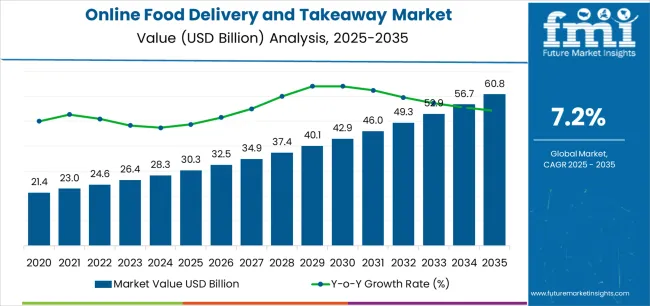
| Metric | Value |
|---|---|
| Online Food Delivery and Takeaway Market Estimated Value in (2025 E) | USD 30.3 billion |
| Online Food Delivery and Takeaway Market Forecast Value in (2035 F) | USD 60.8 billion |
| Forecast CAGR (2025 to 2035) | 7.2% |
The market is segmented by Product Type, Price Range, and Distribution Channel and region. By Product Type, the market is divided into Non-Vegetarian and Vegetarian. In terms of Price Range, the market is classified into Mid, High, and Low. Based on Distribution Channel, the market is segmented into Online Channels, Fast Food, Chain Restaurants, Independent Restaurants, and Others. Regionally, the market is classified into North America, Latin America, Western Europe, Eastern Europe, Balkan & Baltic Countries, Russia & Belarus, Central Asia, East Asia, South Asia & Pacific, and the Middle East & Africa.

The non-vegetarian segment, accounting for 63.4% of the product type category, has been leading the market due to its broad consumer base and higher frequency of repeat orders. Demand growth is being supported by increasing preference for protein-rich diets and the availability of diverse cuisines across delivery platforms.
Market traction has been reinforced by improved cold-chain logistics, ensuring product quality and timely delivery. Restaurants and cloud kitchens have been expanding non-vegetarian menu options to cater to regional taste preferences and premium dining experiences.
This segment’s dominance is expected to persist as disposable incomes rise and consumers continue to seek variety and convenience in meal choices, further consolidating its position within the online food delivery and takeaway ecosystem.
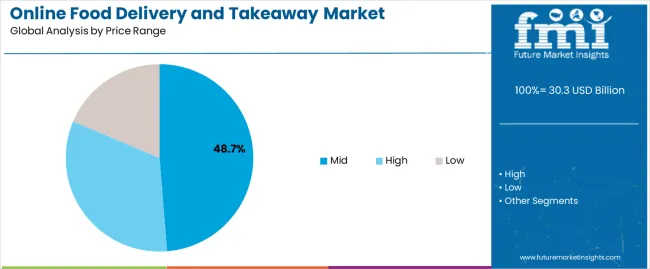
The mid-range price category, representing 48.7% of the price range segment, has emerged as the most preferred due to its balance between affordability and quality. Consumers within this range demonstrate high order frequency, supported by value-driven promotions and combo meal offerings.
Market performance in this category is being strengthened by growing demand from urban working professionals and families seeking cost-effective yet premium-quality meals. Platform providers are optimizing pricing algorithms and loyalty rewards to enhance retention in this segment.
The stability of the mid-range category reflects sustained demand elasticity and brand loyalty, ensuring it remains the largest contributor to revenue within the online food delivery landscape.

The online channels segment, holding 52.9% of the distribution channel category, dominates the market as digital platforms continue to streamline the ordering and delivery process. The growth of mobile applications, integration of AI-based recommendation systems, and secure payment gateways have enhanced user experience and transaction reliability.
Market leadership is being maintained through aggressive promotional strategies, fast delivery guarantees, and wide restaurant network coverage. Partnerships with local eateries and large franchises have improved accessibility, while data analytics and predictive modeling are optimizing delivery times and customer satisfaction.
Continuous platform innovation and improved user interface designs are expected to sustain dominance of online channels, driving consistent revenue generation and long-term market growth.
With the growth of online food delivery and takeaway platforms, ghost kitchens and virtual restaurants are also experiencing a notable surge. These establishments operate exclusively for delivery and takeaway orders. These restaurants are offering contactless delivery options to prioritize safety and convenience. Besides this, online food delivery applications are also using AI and machine learning algorithms to improve personalized recommendations.
The ongoing trend of health-conscious dietary habits has also influenced the online food delivery and takeaway market. Food delivery platforms are also offering vegan, vegetarian, gluten-free, and keto options to cater to the demands of people with specific dietary preferences. Apart from this, these companies are also focusing on sustainable packaging and eco-friendly delivery practices to meet the needs of eco-conscious consumers.
The online food delivery and takeaway market is heavily dependent on partnerships between delivery platforms and restaurants. Any disruptions in this partnership due to improper distribution of profits impede the adoption of these platforms for future food deliveries. Individuals also find online-ordered food expensive due to various charges, such as delivery charges, taxes, etc., included in them. This also is a key deterrent for the online food delivery and takeaway market.
The online food delivery and takeaway platform market is also very competitive due to the presence of numerous players. This cut-throat competition leads to reduced profit margins for restaurants. Besides this, changing the dietary preferences of health-conscious individuals who prefer home-cooked food over restaurant food is also slowing down the adoption of this market.
On the basis of product type, the market is segmented into vegetarian and non-vegetarian. The non-vegetarian segment is anticipated to hold a share of 89.40% of the overall online food delivery and takeaway market.
| Attributes | Details |
|---|---|
| Product Type | Non-vegetarian |
| Market Share in 2025 | 89.40% |
Non-vegetarian food is being increasingly consumed by people in the developed and developing parts of the world. Individuals are also ordering non-vegetarian food through online food delivery and takeaway platforms as they get to enjoy diverse cuisines within a few clicks. Non-vegetarian food is also increasingly visible and celebrated on these platforms, which has also LED to people preferring it over vegetarian alternatives.
Based on the price range, low priced segment takes the maximum share of the online food delivery and takeaway market. It is anticipated to hold a market value of 55.30%.
| Attributes | Details |
|---|---|
| Price Range | Low |
| Market Share in 2025 | 55.30% |
Consumers of online food delivery and takeaway platforms often find low-cost food options more affordable than dining out at restaurants or preparing meals at home. These platforms also offer convenience by allowing users to order food with just a few clicks or taps on their smartphones or computers.
Besides this, meal delivery platforms offer a wide variety of low-cost food options such as fast food, street food, and budget-friendly meals from local eateries. These options also attract cost-sensitive consumers to the market, augmenting the overall adoption.
This section offers a comprehensive analysis of the online food delivery and takeaway market across various countries, including the United States, China, Germany, Japan, and India. The table presents the forecasted CAGR for each country, depicting the estimated market growth in these countries until 2035.
| Countries | Forecasted CAGR from 2025 to 2035 |
|---|---|
| India | 6.90% |
| Japan | 6.40% |
| Germany | 5.10% |
| United States | 4.20% |
| China | 3.90% |
India also exhibits a promising future in the online food delivery and takeaway industry. The online food delivery and takeaway industry in India is anticipated to retain its ascendency by progressing at a CAGR of 6.90% till 2035.
India has a large youth population, which is tech-savvy and prefers the convenience of ordering food online. The expanding middle class in India, with more disposable income, is one of the main reasons why the Indian market for online food delivery and takeaway platforms has been experiencing a surge. This demographics’ willingness to spend a little extra on online-ordered food has contributed to the growth in the past few years.
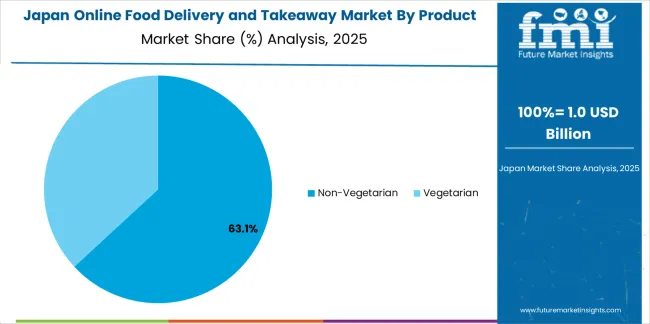
Japan is also one of the lucrative markets when it comes to the online food delivery and takeaway industry. The online food delivery and takeaway market in Japan is anticipated to develop at a CAGR of 6.40%.
Japan's aging population is one of the main reasons for the proliferation of online food delivery and takeaway platforms in the country. This is because the geriatric population is increasingly turning to online food delivery services for convenience and accessibility. Besides this, the compact urban living spaces and long working hours make online food delivery a convenient option for busy urban dwellers.
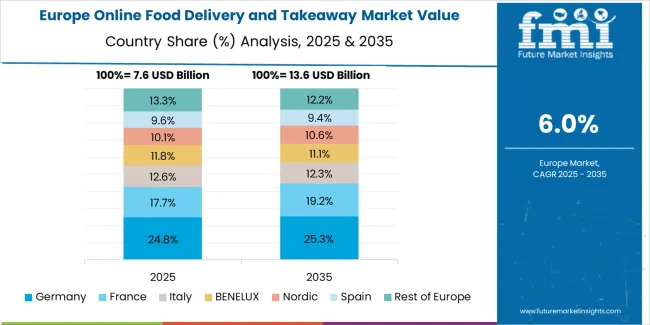
Germany also is a promising market in the online food delivery and takeaway industry. Over the next ten years, the demand for online food delivery and takeaway in Germany is projected to rise at a 5.10% CAGR.
People, in general, have become more accustomed to using digital technology for various aspects of their lives, especially for ordering food in Germany. This factor is considered one of the main reasons for the growth of the online food delivery and takeaway market in the country. The entry of multinational food chains and eateries in the country has also pushed the delivery culture in the general population, further augmenting the adoption in Germany.
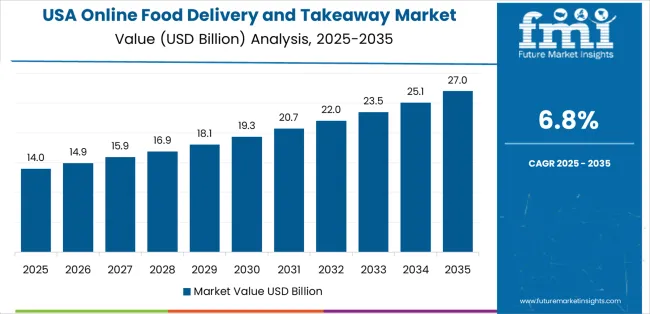
The United States is expected to exhibit significant market growth over the forecast period. The United States online food delivery and takeaway market is anticipated to progress at a CAGR of 4.20% through 2035.
The United States has a well-established chain of hotels and restaurants. Even before the advent of the Internet, these restaurants offered last-mile delivery options through phone calls. This familiarity with food delivery and takeaway culture has made it easier for online platforms to manage the logistics in the country.
Besides this, culinary diversity contributes to the healthy growth of the online food delivery and takeaway industry in the United States. Additionally, the affluent population, who can afford costly food items, further boosts this trend.
China is also one of the lucrative markets in the East Asia online food delivery and takeaway industry. The online food delivery and takeaway market in China is anticipated to roar at a CAGR of 3.90% through 2035.
In the last few decades, China has undergone serious urbanization. This has LED to immense migration of people to the urban areas, leaving their families and homes behind. As more and more individuals seek home-cooked food, the demand for online food delivery and takeaway platforms is anticipated to experience a surge. Apart from this, the increasing adoption of online mobile payment systems, such as Alipay and WeChat Pay, has also facilitated the growth of online food delivery platforms in China.
Uber Eats, DoorDash, Grubhub, Just Eat Takeaway.com, Zomato, Swiggy, Meituan Dianping, Delivery Hero, Deliveroo, Ele.me are some of the most prominent companies in the global market for online food delivery and takeaway systems. These companies are coming up with exclusive offers and discount plans to attract more consumers to their platforms.
To stay more competitive in the market, these companies are also embracing sustainable packaging and delivery practices. Apart from this, key players are also offering additional coupons and cashback if the food is not delivered at the aforementioned time.
Recent Developments
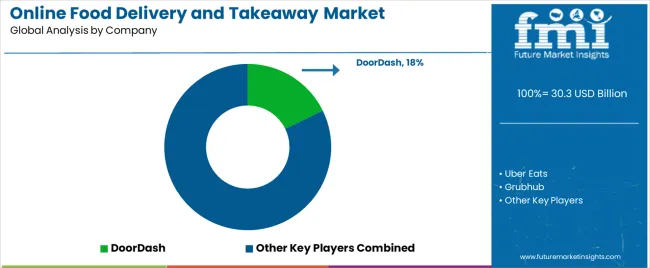
The global online food delivery and takeaway market is estimated to be valued at USD 30.3 billion in 2025.
The market size for the online food delivery and takeaway market is projected to reach USD 60.8 billion by 2035.
The online food delivery and takeaway market is expected to grow at a 7.2% CAGR between 2025 and 2035.
The key product types in online food delivery and takeaway market are non-vegetarian and vegetarian.
In terms of price range, mid segment to command 48.7% share in the online food delivery and takeaway market in 2025.






Our Research Products

The "Full Research Suite" delivers actionable market intel, deep dives on markets or technologies, so clients act faster, cut risk, and unlock growth.

The Leaderboard benchmarks and ranks top vendors, classifying them as Established Leaders, Leading Challengers, or Disruptors & Challengers.

Locates where complements amplify value and substitutes erode it, forecasting net impact by horizon

We deliver granular, decision-grade intel: market sizing, 5-year forecasts, pricing, adoption, usage, revenue, and operational KPIs—plus competitor tracking, regulation, and value chains—across 60 countries broadly.

Spot the shifts before they hit your P&L. We track inflection points, adoption curves, pricing moves, and ecosystem plays to show where demand is heading, why it is changing, and what to do next across high-growth markets and disruptive tech

Real-time reads of user behavior. We track shifting priorities, perceptions of today’s and next-gen services, and provider experience, then pace how fast tech moves from trial to adoption, blending buyer, consumer, and channel inputs with social signals (#WhySwitch, #UX).

Partner with our analyst team to build a custom report designed around your business priorities. From analysing market trends to assessing competitors or crafting bespoke datasets, we tailor insights to your needs.
Supplier Intelligence
Discovery & Profiling
Capacity & Footprint
Performance & Risk
Compliance & Governance
Commercial Readiness
Who Supplies Whom
Scorecards & Shortlists
Playbooks & Docs
Category Intelligence
Definition & Scope
Demand & Use Cases
Cost Drivers
Market Structure
Supply Chain Map
Trade & Policy
Operating Norms
Deliverables
Buyer Intelligence
Account Basics
Spend & Scope
Procurement Model
Vendor Requirements
Terms & Policies
Entry Strategy
Pain Points & Triggers
Outputs
Pricing Analysis
Benchmarks
Trends
Should-Cost
Indexation
Landed Cost
Commercial Terms
Deliverables
Brand Analysis
Positioning & Value Prop
Share & Presence
Customer Evidence
Go-to-Market
Digital & Reputation
Compliance & Trust
KPIs & Gaps
Outputs
Full Research Suite comprises of:
Market outlook & trends analysis
Interviews & case studies
Strategic recommendations
Vendor profiles & capabilities analysis
5-year forecasts
8 regions and 60+ country-level data splits
Market segment data splits
12 months of continuous data updates
DELIVERED AS:
PDF EXCEL ONLINE
Online Food Delivery Services Market Outlook - Growth, Demand & Forecast 2025 to 2035
Insulated Food Delivery Bags Market Analysis – Growth & Forecast 2025 to 2035
Hyperlocal Food Delivery Market Trends - Convenience & Growth 2025 to 2035
Online Sweepstakes Platform Market Size and Share Forecast Outlook 2025 to 2035
Food & Beverage OEE Software Market Size and Share Forecast Outlook 2025 to 2035
Food Grade Crosslinked Polyvinylpolypyrrolidone (PVPP) Market Size and Share Forecast Outlook 2025 to 2035
Food Grade Cassia Gum Powder Market Size and Share Forecast Outlook 2025 to 2035
Food Grade Dry Film Lubricant Market Size and Share Forecast Outlook 2025 to 2035
Online Clothing Rental Market Size and Share Forecast Outlook 2025 to 2035
Foodservice Equipment Market Analysis - Size, Share, and Forecast Outlook 2025 to 2035
Food Basket Market Forecast and Outlook 2025 to 2035
Online Leadership Development Program Market Forecast and Outlook 2025 to 2035
Food Grade Tremella Polysaccharide Market Size and Share Forecast Outlook 2025 to 2035
Food Sorting Machine Market Size and Share Forecast Outlook 2025 to 2035
Foodservice Paper Bag Market Size and Share Forecast Outlook 2025 to 2035
Food Stabilizers Market Size and Share Forecast Outlook 2025 to 2035
Food Packaging Film Market Size and Share Forecast Outlook 2025 to 2035
Food Certification Market Size and Share Forecast Outlook 2025 to 2035
Food Tray Market Size and Share Forecast Outlook 2025 to 2035
Food & Beverage Industrial Disinfection and Cleaning Market Size and Share Forecast Outlook 2025 to 2035

Thank you!
You will receive an email from our Business Development Manager. Please be sure to check your SPAM/JUNK folder too.
Chat With
MaRIA